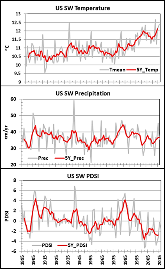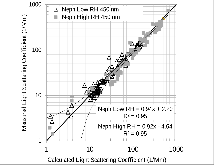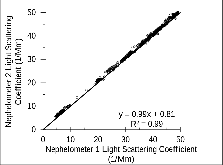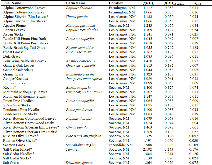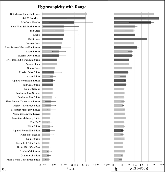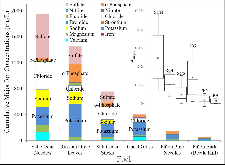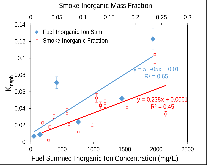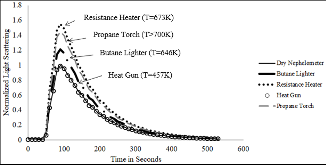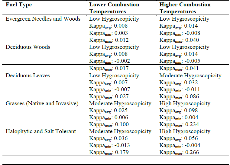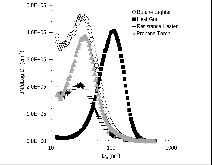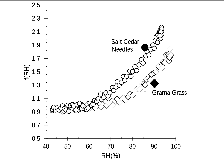|
A three-dimensional sectional representation of aerosol mixing state for simulating optical properties and cloud condensation nuclei: Aerosol Mixing State Representation
|
journal
|
May 2016 |
|
Rapidly evolving ultrafine and fine mode biomass smoke physical properties: Comparing laboratory and field results: Rapidly Evolving Biomass Smoke
|
journal
|
May 2016 |
|
Ambient observations of hygroscopic growth factor and f (RH) below 1: Case studies from surface and airborne measurements: Sub-1 Hygroscopicity Field Measurements
|
journal
|
November 2016 |
|
Seven years of aerosol scattering hygroscopic growth measurements from SGP: Factors influencing water uptake
|
journal
|
September 2017 |
|
High resilience of the mycorrhizal community to prescribed seasonal burnings in eastern Mediterranean woodlands
|
journal
|
January 2021 |
|
Smoke-impacted regional haze in California during the summer of 2002
|
journal
|
March 2006 |
|
Hygroscopic growth behavior of a carbon-dominated aerosol in Yosemite National Park
|
journal
|
March 2005 |
|
Determination of levoglucosan in biomass combustion aerosol by high-performance anion-exchange chromatography with pulsed amperometric detection
|
journal
|
January 2006 |
|
Effect of hygroscopic growth on the aerosol light-scattering coefficient: A review of measurements, techniques and error sources
|
journal
|
September 2016 |
|
Low hygroscopicity of ambient fresh carbonaceous aerosols from pyrotechnics smoke
|
journal
|
April 2018 |
|
Climate change impacts on fire regimes and key ecosystem services in Rocky Mountain forests
|
journal
|
September 2014 |
|
Comparative ecophysiology of Tamarix ramosissima and native trees in western U.S. riparian zones
|
journal
|
May 2005 |
|
First results from light scattering enhancement factor over central Indian Himalayas during GVAX campaign
|
journal
|
December 2017 |
|
Impact, Biology, and Ecology of Saltcedar ( Tamarix spp.) in the Southwestern United States
|
journal
|
June 1998 |
|
Complex Refractive Indices of Aerosols Retrieved by Continuous Wave-Cavity Ring Down Aerosol Spectrometer
|
journal
|
March 2009 |
|
Evaporation of Ammonium Nitrate Aerosol in a Heated Nephelometer: Implications for Field Measurements
|
journal
|
October 1997 |
|
Emission of trace gases and aerosols from biomass burning
|
journal
|
December 2001 |
|
Smoke aerosol from biomass burning in Mexico: Hygroscopic smoke optical model
|
journal
|
March 2001 |
|
Mixtures of pollution, dust, sea salt, and volcanic aerosol during ACE-Asia: Radiative properties as a function of relative humidity
|
journal
|
January 2003 |
|
Spatial and monthly trends in speciated fine particle concentration in the United States: SPECIATED FINE PARTICLE CONCENTRATION
|
journal
|
February 2004 |
|
Humidification factors from laboratory studies of fresh smoke from biomass fuels
|
journal
|
January 2006 |
|
Aerosol hygroscopicity and cloud droplet activation of extracts of filters from biomass burning experiments
|
journal
|
January 2008 |
|
A method for smoke marker measurements and its potential application for determining the contribution of biomass burning from wildfires and prescribed fires to ambient PM 2.5 organic carbon
|
journal
|
January 2008 |
|
Ice nuclei emissions from biomass burning
|
journal
|
January 2009 |
|
Cloud condensation nucleation activity of biomass burning aerosol
|
journal
|
January 2009 |
|
Biomass burning smoke aerosol properties measured during Fire Laboratory at Missoula Experiments (FLAME)
|
journal
|
January 2010 |
|
Humidification factors of aerosols from biomass burning in Brazil
|
journal
|
December 1998 |
|
Hygroscopic properties of potassium chloride and its internal mixtures with organic compounds relevant to biomass burning aerosol particles
|
journal
|
February 2017 |
|
Water, climate change, and sustainability in the southwest
|
journal
|
December 2010 |
|
Size-Resolved Anhydrosugar Composition in Smoke Aerosol from Controlled Field Burning of Rice Straw
|
journal
|
June 2009 |
|
Aircraft Instrument for Comprehensive Characterization of Aerosol Optical Properties, Part I: Wavelength-Dependent Optical Extinction and Its Relative Humidity Dependence Measured Using Cavity Ringdown Spectroscopy
|
journal
|
November 2011 |
|
Observation of Superaggregates from a Reversed Gravity Low-Sooting Flame
|
journal
|
January 2012 |
|
Determining Aerosol Radiative Properties Using the TSI 3563 Integrating Nephelometer
|
journal
|
January 1998 |
|
Distribution and Abundance of Saltcedar and Russian Olive in the Western United States
|
journal
|
November 2011 |
|
Woodsmoke Health Effects: A Review
|
journal
|
January 2007 |
|
Visibility: Science and Regulation
|
journal
|
June 2002 |
|
Impacts of increasing aridity and wildfires on aerosol loading in the intermountain Western US
|
journal
|
January 2017 |
|
The origin of the savanna biome
|
journal
|
November 2006 |
|
Mechanisms of plant survival and mortality during drought: why do some plants survive while others succumb to drought?
|
journal
|
June 2008 |
|
Warming and Earlier Spring Increase Western U.S. Forest Wildfire Activity
|
journal
|
August 2006 |
|
The Impact of Boreal Forest Fire on Climate Warming
|
journal
|
November 2006 |
|
Fire in the Earth System
|
journal
|
April 2009 |
|
Direct Radiative Forcing by Smoke from Biomass Burning
|
journal
|
March 1997 |
|
A human-driven decline in global burned area
|
journal
|
June 2017 |
|
Mechanisms of Salinity Tolerance
|
journal
|
June 2008 |
|
Biological Invasions by Exotic Grasses, the Grass/Fire Cycle, and Global Change
|
journal
|
November 1992 |
|
Cloud condensation nuclei activity of fresh primary and aged biomass burning aerosol
|
text
|
January 2012 |
|
Cloud condensation nuclei activity of fresh primary and aged biomass burning aerosol
|
text
|
January 2018 |
|
Genome downsizing, physiological novelty, and the global dominance of flowering plants
|
journal
|
January 2018 |
|
Acclimation and Adaptive Responses of Woody Plants to Environmental Stresses
|
journal
|
April 2002 |
|
Ecological Restoration of Southwestern Ponderosa pine Ecosystems: a Broad Perspective
|
journal
|
October 2002 |
|
On underestimation of global vulnerability to tree mortality and forest die-off from hotter drought in the Anthropocene
|
journal
|
August 2015 |
|
Climate Change and Future Fire Regimes: Examples from California
|
journal
|
August 2016 |
|
Mexico city aerosol analysis during MILAGRO using high resolution aerosol mass spectrometry at the urban supersite (T0) – Part 2: Analysis of the biomass burning contribution and the non-fossil carbon fraction
|
text
|
January 2010 |
|
Water uptake and chemical composition of fresh aerosols generated in open burning of biomass
|
journal
|
January 2010 |
|
Mexico city aerosol analysis during MILAGRO using high resolution aerosol mass spectrometry at the urban supersite (T0) – Part 2: Analysis of the biomass burning contribution and the non-fossil carbon fraction
|
journal
|
January 2010 |
|
Measured and modeled humidification factors of fresh smoke particles from biomass burning: role of inorganic constituents
|
journal
|
January 2010 |
|
Cloud condensation nuclei activity of fresh primary and aged biomass burning aerosol
|
journal
|
January 2012 |
|
Airborne characterization of smoke marker ratios from prescribed burning
|
journal
|
January 2014 |
|
Aerosol optical properties in the southeastern United States in summer – Part 1: Hygroscopic growth
|
journal
|
January 2016 |
|
A novel method for deriving the aerosol hygroscopicity parameter based only on measurements from a humidified nephelometer system
|
journal
|
January 2017 |
|
A single parameter representation of hygroscopic growth and cloud condensation nucleus activity
|
journal
|
January 2007 |
|
Measurement of ambient aerosols in northern Mexico City by single particle mass spectrometry
|
journal
|
January 2008 |
|
Characterization of organic ambient aerosol during MIRAGE 2006 on three platforms
|
journal
|
January 2009 |
|
A single parameter representation of hygroscopic growth and cloud condensation nucleus activity
|
journal
|
January 2006 |
|
Measurement of ambient aerosols in northern Mexico City by single particle mass spectrometry
|
journal
|
January 2007 |
|
Description and evaluation of a new four-mode version of the Modal Aerosol Module (MAM4) within version 5.3 of the Community Atmosphere Model
|
journal
|
January 2016 |
|
Mexico city aerosol analysis during MILAGRO using high resolution aerosol mass spectrometry at the urban supersite (T0) - Part 2: Analysis of the biomass burning contribution and the non-fossil carbon fraction
|
text
|
January 2010 |
